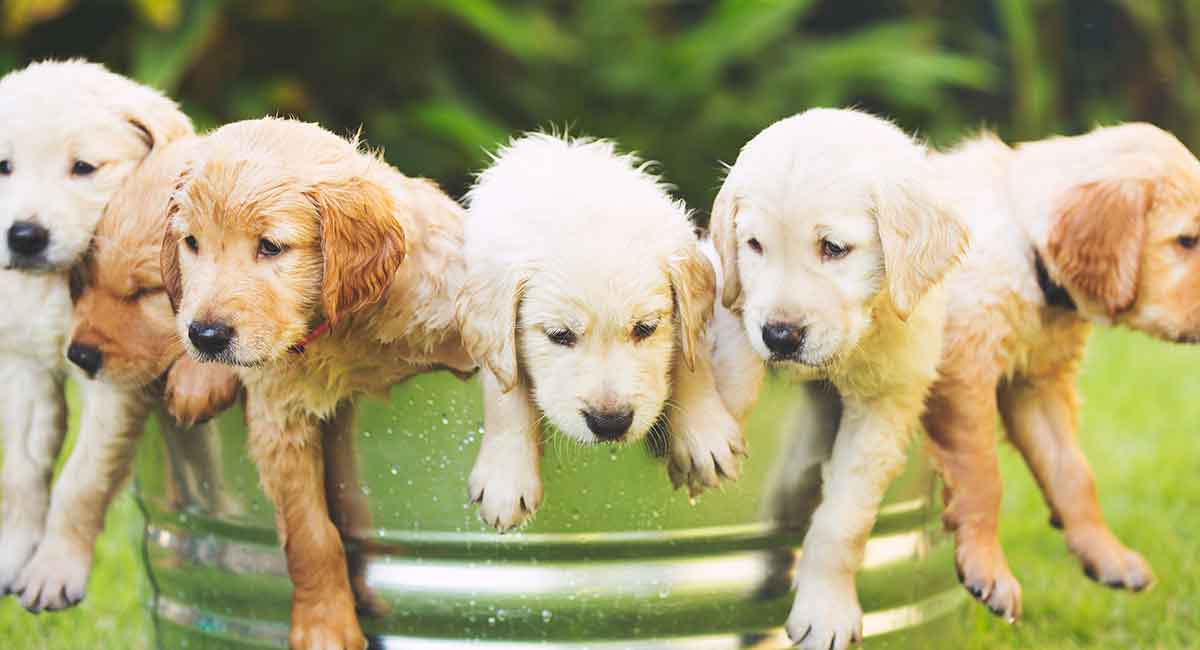
The range of dog colors out there is quite astonishing.
From purest white to brightest red, soft grey to intense blue.
Not to mention the incredible patterns and markings our canines companions can carry.
It's easy to get lost in a world of shades, tones and hues that goes beyond our expectations.
So we've popped them down into easy to search categories for you!
You can search by your dog's color, breed and other characteristics too.
Search By Color
Dogs come in some fabulous shades.
To dive right in to the color of your choice, click the image below:
BLACK
BLUE
BROWN
Dog Breeds By Color
In the categories below you'll find some dogs, like the Weimaraner, in only one group.
But other breeds, like the Labrador, will appear in several.
Whatever dog colors you are interested in, there are some lovely breeds waiting to be found.
Black Dog Breeds
These beautiful black dogs might share a color, but there are some serious differences.
From petite and tiny, to award winningly enormous.
Shy and retiring to packed with bravery and loyalty.
Click on the images below to find out more about your chosen breed!
POMERANIAN
POODLE
There are also some gorgeous black mixed breeds, like the lovely black Goldendoodle!
Blue Dog Breeds
Beautiful blue dogs come in an array of shades and patterns.
From flecks to a bright hue, to a steely blue grey.
These dogs are all united in being serious head turners at the dog park.
BORDER COLLIE
CHIHUAHUA
FRENCH BULLDOG
GREAT DANE
IRISH WOLFHOUND
ITALIAN GREYHOUND
Brown Dog Breeds
Often known as liver or chocolate, brown dogs come in a variety of shades.
Whether it's the soft delicate brown of a Spaniel, or the deep richness of the Labrador.
These really are some of the most brilliant dog colors!
MOUNTAIN CUR
POODLE
Cream Dog Breeds
Gorgeous cream dogs are a shade darker than white.
With glossy coats and a stellar shine, these creamy canines really are the pick of the pack.
AFGHAN HOUND
BORZOI
CAIRN TERRIER
COCKER SPANIEL
DACHSHUND
GOLDEN RETRIEVER
Gold Dog Breeds
From lightest ginger to almost auburn, these golden wonders really are something.
A rich shade, these dogs' coats shine like the sunset.
And they come in a real range of sizes, shapes and temperaments too.
CAIRN TERRIER
CHIHUAHUA
CHOW CHOW
Grey Dog Breeds
Grey dogs can be a soft pale smokey hue, all the way to a warm dark haze.
Mixed with other colors, or stand alone grit grey, they are all beautiful.
And have unique and wonderful personalities too.
GREAT DANE
IRISH WOLFHOUND
ITALIAN GREYHOUND
Red Dog Breeds
Red dogs are simply stunning. From darkest orange to intense auburn.
Click on the images below to find out more about your chosen breed!
AUSTRALIAN SHEPHERD
COCKER SPANIEL
CORGI
ENGLISH COCKER SPANIEL
GOLDEN RETRIEVER
White Dog Breeds
Ghostly pale yet bold and bright, white dogs are something to behold.
And there are so many of them, too!
Click on the images below to find your perfect white pup.
COTON DE TULEAR
ENGLISH BULLDOG
FRENCH BULLDOG
GERMAN SHEPHERD
GOLDEN RETRIEVER
GREAT PYRENEES
SAMOYED
SIBERIAN HUSKY
WESTIE
Yellow Dog Breeds
Gorgeous, sunny yellow dogs cheer up the darkest days.
And this coat color really pops on some of the most popular breeds around.
From the lovely Labrador Retriever to the petite Pekingese, find your top dog here!
BULLMASTIFF
CAIRN TERRIER
CHOW CHOW
Dog Patterns
Looking for general information on a particular pattern?
Check out their dedicated articles by clicking the pictures below.
Alternatively, scroll down for lists of breeds with these beautiful coats.
Spotty Dog Breeds
Spotted dogs are amazing to look at.
Whether it's tiny flecks, little circles or big splodges of color, these dotty dogs are sure fire crowd pleasers
Click on the photos to find out more about your favorite spotty breed.
Great Dane
Fox Hound
Jack Russell
Brindle Dog Breeds
Brindle dogs have an amazing, speckled coat.
With varying flecks and smudges of black and brown.
Check out the breeds below!
Merle Dog Breeds
Merle dogs have a stunning pattern, that is pretty much unrivalled in the animal kingdom.
But this gene isn't without its drawbacks.
Mate two merle dogs together and risk a genetic disaster!
Fortunately, single merle genes just result in a beautiful dog, with an awesome coat.
Australian Shepherd
Border Collie
Great Dane
Bicolor Dog Breeds
Bicolor dogs have coats with just two colors.
These are usually in patches, and sometimes in predictable places.
Like black and tan, or black and white dogs.
Parti is a popular bicolor pattern, where the coat is at least half white.
Here are some of the most popular bicolor breeds.
Tricolor Dog Breeds
Tricolor dogs have coats made up of three distinct colors.
They can be in certain patterns, but are often in random flecks or patches across their coats.
Click on the images below to learn more about some of these cool dog colors.
Roan Dog Breeds
Merle dogs have a stunning pattern, that is pretty much unrivalled in the animal kingdom.
But this gene isn't without its drawbacks.
Mate two merle dogs together and risk a genetic disaster!
Fortunately, single merle genes just result in a beautiful dog, with an awesome coat.
Dog Colors
The range of dog colors out there is wonderful. And it can be a fun way to look for your next dog.
But make sure that you aren't only guided by their appearance.
Similarly coated pups can have very different personalities, and health requirements too.
By all means be guided by your top colors, but do your research on the breed you've picked before choosing your puppy.
That way, you're sure to be onto a winner!

Leave a Reply